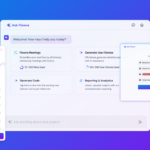
Sprint Project Management: A Step-by-Step Guide to Agile Success
- January 02, 2025
- by
- tehreem
Are you feeling overwhelmed with managing complex projects and striving for better team collaboration? If you’ve ever struggled with project timelines, miscommunication, or scope creep, you’re not alone. Traditional project management methods can often leave you stuck in a loop of delays and confusion, but there’s a better way: Sprint Project Management.
In this article, we’ll guide you step-by-step through Sprint Project Management, one of the core pillars of Agile methodologies. You’ll learn how to plan, execute, and review sprints in a way that fosters team collaboration, boosts productivity, and ensures your projects stay on track. By the end of this guide, you’ll have a clear roadmap to Agile success with Sprint Project Management.
Understanding Sprint Project Management
Sprint Project Management is an essential concept within Agile methodologies. It helps teams break down a project into smaller, manageable pieces, each called a “sprint.” But what exactly is Sprint Project Management, and why is it gaining so much traction?
What is Sprint Project Management?
Sprint Project Management is an iterative process that breaks a larger project into smaller tasks, allowing teams to focus on delivering value in short, focused bursts of time. Each sprint typically lasts between one to four weeks and involves a structured approach to planning, executing, and reviewing.
This approach enables teams to remain flexible, adapt to changes quickly, and ensure continuous progress. By embracing Sprint Project Management, businesses can improve efficiency, reduce risk, and enhance collaboration, leading to more successful project outcomes.
Why Is Sprint Project Management Important?
Sprint Project Management has gained popularity because it allows for continuous feedback and improvement, unlike traditional project management methods that rely on long-term, rigid plans. In Agile frameworks like Scrum, the focus is on delivering high-quality results at the end of each sprint, with frequent check-ins to ensure alignment with overall goals.
The Agile Framework and Its Relationship with Sprints
Agile is a project management philosophy that values flexibility, customer collaboration, and responding to change over following a strict plan. It emphasizes delivering incremental improvements and leveraging team collaboration to achieve project success.
How Sprints Fit into the Agile Framework
In Agile, projects are divided into smaller chunks of work called “iterations” or “sprints.” Each sprint lasts for a set duration, typically 2-4 weeks, and focuses on delivering a specific feature, functionality, or outcome. During this period, teams collaborate closely, adapt to changes, and make quick adjustments to ensure continuous progress.
The Role of Scrum in Sprint Project Management
Scrum is one of the most popular Agile frameworks that use Sprint Project Management to structure work. Scrum defines specific roles, such as Scrum Master, Product Owner, and Development Team, to ensure everyone has a clear understanding of their responsibilities.
By using Scrum’s iterative approach to Sprint Project Management, teams can remain focused, track progress with ease, and deliver valuable results consistently.
Preparing for a Successful Sprint
Preparation is key when it comes to Sprint Project Management. A well-executed sprint starts with clear goals, effective communication, and the right tools. Let’s dive into the preparation phase to ensure your sprint sets you up for success.
Setting Clear Objectives and Goals
Every sprint must begin with a clear set of goals and objectives. These should align with the overall project vision and be achievable within the sprint’s time frame. Defining specific, measurable, attainable, relevant, and time-bound (SMART) goals helps keep your team on track and focused.
Assembling the Right Team
A successful sprint requires a well-balanced team. In Agile frameworks like Scrum, the team should include a Scrum Master, a Product Owner, and a Development Team. The Scrum Master ensures that the team follows the Scrum process, while the Product Owner manages the product backlog, prioritizing tasks based on business value.
Establishing Effective Communication Channels
One of the cornerstones of Sprint Project Management is communication. Ensure that your team is clear on the project goals, deliverables, and timelines. Set up regular check-ins, such as daily stand-up meetings, to discuss progress, potential roadblocks, and any other concerns.
Selecting Appropriate Tools and Resources
Choose project management tools that suit your team’s needs. Tools like Jira, Trello, and Asana are great for managing tasks, tracking progress, and ensuring transparency across the team. Additionally, collaboration tools like Slack or Microsoft Teams can help streamline communication.
Planning Your Sprint
With your preparation in place, it’s time to plan the sprint. Effective sprint planning ensures that the team knows exactly what needs to be done and in what order.
Conducting Sprint Planning Meetings
Sprint planning meetings are where the team decides what work will be completed during the sprint. The Product Owner presents the backlog items, and the team collaboratively discusses which tasks are achievable within the sprint timeframe.
Defining the Sprint Backlog
The sprint backlog is a list of tasks or user stories that the team commits to completing during the sprint. Each item in the backlog should be well-defined, with clear acceptance criteria. This ensures that everyone is aligned on what needs to be delivered and what constitutes “done.”
Estimating Tasks and Setting Priorities
One of the key aspects of sprint planning is estimating the time and effort required for each task. Teams often use story points or time-based estimates to gauge the complexity of each task. Setting priorities is equally important – high-priority items should be tackled first to ensure maximum value is delivered.
Establishing a Sprint Timeline
While sprints are time-boxed, setting a clear timeline helps ensure that tasks are completed efficiently. A typical sprint lasts 2-4 weeks, with a fixed start and end date. This timeline allows teams to focus on a manageable set of tasks while minimizing the risk of delays.
Executing the Sprint
Now comes the fun part: executing the sprint. This phase is all about delivering results and keeping the team on track.
Daily Stand-Up Meetings
A hallmark of Sprint Project Management is the daily stand-up meeting. This short, focused meeting allows team members to discuss what they’ve accomplished, what they’re working on, and any obstacles they’re facing. Stand-ups are typically time-boxed to 15 minutes to ensure they remain brief and focused.
Monitoring Progress and Addressing Obstacles
Throughout the sprint, it’s essential to monitor progress regularly. Use tools like burndown charts to track how much work remains. If any obstacles arise, address them quickly and collaboratively. The Scrum Master plays a key role in removing impediments and keeping the team focused.
Maintaining Team Motivation and Focus
Keeping the team motivated and focused is critical for successful sprint execution. Encourage open communication, celebrate small wins, and ensure everyone feels supported. A motivated team will be more productive, engaged, and collaborative.
Reviewing and Retrospecting
After the sprint concludes, it’s time for a review and retrospective. These meetings allow the team to evaluate their performance and identify areas for improvement.
Conducting Sprint Reviews
Sprint reviews are held at the end of the sprint to assess what was delivered. The Product Owner presents the completed work to stakeholders, who provide feedback. This feedback loop helps ensure that the project remains aligned with business goals and customer expectations.
Identifying Areas for Improvement
The sprint retrospective is a meeting where the team reflects on what went well and what could be improved. This is an opportunity to identify bottlenecks, communication issues, or other areas that may have hindered performance.
Implementing Changes for Future Sprints
After the retrospective, the team should make actionable plans for improving the next sprint. These could include refining the sprint planning process, improving communication, or introducing new tools or practices.
Common Challenges in Sprint Project Management and How to Overcome Them
Like any project management approach, Sprint Project Management comes with its challenges. Here’s how to address some common issues.
Managing Scope Creep
Scope creep occurs when additional work is added to the sprint without considering its impact on the timeline or resources. To manage scope creep, ensure that any new work is carefully evaluated before being added to the sprint backlog.
Handling Team Conflicts
Team conflicts can arise when team members have differing opinions or face obstacles. Encourage open communication, active listening, and conflict resolution strategies to keep the team united and focused on the goal.
Dealing with Unforeseen Obstacles
Unexpected roadblocks can derail even the best-laid plans. It’s crucial to have a proactive approach to problem-solving, with the Scrum Master stepping in to help resolve issues quickly.
Strategies for Continuous Improvement
Finally, don’t forget that Sprint Project Management is about continuous improvement. Always be on the lookout for ways to enhance your processes, communication, and tools to optimize the next sprint.
Frequently Asked Questions (FAQs)
- What is the ideal duration for a sprint?
- The ideal duration for a sprint typically ranges from 1 to 4 weeks. It should be short enough to maintain focus and momentum but long enough to deliver meaningful work.
- The ideal duration for a sprint typically ranges from 1 to 4 weeks. It should be short enough to maintain focus and momentum but long enough to deliver meaningful work.
- How do you handle changes during a sprint?
- Changes should be carefully managed during a sprint. If the scope needs to change, it should be evaluated and prioritized for the next sprint. Major changes mid-sprint can disrupt progress.
- Changes should be carefully managed during a sprint. If the scope needs to change, it should be evaluated and prioritized for the next sprint. Major changes mid-sprint can disrupt progress.
- What are the key roles in Sprint Project Management?
- The key roles include the Scrum Master, Product Owner, and Development Team. Each role has a unique responsibility in ensuring the sprint is executed successfully.
- The key roles include the Scrum Master, Product Owner, and Development Team. Each role has a unique responsibility in ensuring the sprint is executed successfully.
- How do you measure the success of a sprint?
- Success is measured by the completion of the sprint backlog items, stakeholder satisfaction, and the ability to meet sprint goals. Feedback from stakeholders and the team’s performance in retrospectives are also indicators of success.
Ready to transform your project management with Sprint Project Management? Whether you’re just starting with Agile or looking to optimize your existing processes, planning and executing sprints can boost your team’s efficiency and deliver exceptional results.
Create your sprint project with AI using Ontezo—our platform helps you create your sprint backlog and plan your first sprint in minutes with the power of artificial intelligence. Ontezo’s smart features streamline sprint planning, task prioritization, and progress tracking, so you can focus on what matters most—delivering results.
Let’s start today and experience how easy and efficient Sprint Project Management can be with Ontezo. Your Agile success is just a click away!







1 Comment
How Better Email Management Can Save You Time and Resources? - Ontezo Blogs
7th Feb 2025 - 11:25 am[…] Sprint Project Management: A Step-by-Step Guide to Agile Success […]